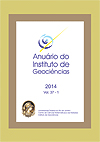A Study of the Phenomenon of Urban Heat Island in Rio de Janeiro Metropolitan Region
DOI:
https://doi.org/10.11137/2014_2_180_194Keywords:
Urban Heat, RMRJ, NOAA -- 14 and 18 satellites.Abstract
The main objective of this study is analyze the field of Surface Temperature (TS) of the Metropolitan Region of Rio de Janeiro (RMRJ) and its relation to land use. The analysis was based on vegetation index NDVI and TS values obtained from NOAA - 14 and 18 images covering the 2005 to 2010 years. The Maximum Value Composite method was used to generate of TS and NDVI monthly maps and also for all data period. The different statistical parameters (e.g. correlation and determination coefficients, linear regression and standard deviation) were calculated to determine the relationship between TS and NDVI. The TS monthly values for NOAA - 14 satellite shown to be high in the early morning, although slightly lower than NOAA - 18 satellite due to the different times of passage. It was observed that Urban Heat Island (ICU) phenomenon operates throughout the year, especially in the eastern portion of the city and in the Baixada Fluminense cities. The inverse relationship between TS and NDVI was observed mainly in the autumn and winter months with the highest correlation and determination coefficients. However, this is not observed in the summer months because the heating effect of macroscale (weather effects) overlaps with land use.Downloads
Download data is not yet available.
Downloads
Published
2017-02-15
How to Cite
Meireles, V. H. P. de, França, J. R. de A. and Peres, L. F. (2017) “A Study of the Phenomenon of Urban Heat Island in Rio de Janeiro Metropolitan Region”, Anuário do Instituto de Geociências. Rio de Janeiro, BR, 37(2), pp. 180–194. doi: 10.11137/2014_2_180_194.
Issue
Section
Article
License
This journal is licensed under a Creative Commons — Attribution 4.0 International — CC BY 4.0, which permits use, distribution and reproduction in any medium, provided the original work is properly cited.















